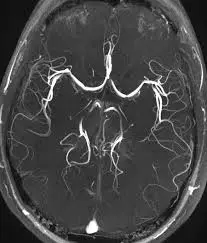如何解读血管造影MRI:3个必备技巧
理解血管造影MRI对于有效诊断和治疗血管疾病至关重要。本指南将向您介绍MRI相较于传统血管造影的优势,并解释解读这些详细图像的三个关键技巧。
理解血管造影MRI
血管造影MRI提供了血管的全面视图,给出动脉、静脉和血管结构的详细图像。本节概述了什么是血管造影MRI及其在诊断各种疾病中的优势。

血管造影MRI显示了什么?
- 血管细节: 对动脉和静脉的优越成像。
- 血流动态: 清晰可视化血流,方便诊断堵塞或动脉瘤。
- 软组织背景: 显示周围组织以便全面分析。
- 疾病检测: 在识别血管疾病和异常方面更有效。
何时会进行血管造影MRI?
- 中风症状: 尤其是在其他成像测试结果不确定的情况下。
- 血管疾病: 如动脉瘤或动脉堵塞。
- 手术前规划: 提供详细的解剖信息以便于手术规划。
- 监测血管状况: 理想用于评估慢性血管疾病随时间的变化。
解释血管造影MRI的技巧
解释血管造影MRI需要对先进成像技术有更深入的了解。以下是适用于不同专业水平的三种技巧。
1. 使用X-ray Interpreter
X-ray Interpreter现在将其AI驱动的分析扩展到MRI图像。该过程确保精确:
- 注册: 在X-ray Interpreter上注册以访问MRI的AI分析。
- 上传MRI: 上传您的血管造影MRI图像。
- 审查解释: 接收AI生成的解释并下载您的报告。
- 专业咨询: 始终建议咨询医疗专业人士以获得全面理解。
请查看我们的入门指南以获取更多信息。
2. 使用ChatGPT Plus
ChatGPT Plus现在支持其最新的GPT-4V模型进行MRI图像分析,提供详细和互动的见解:
- 订阅: 订阅ChatGPT Plus以获得高级图像分析功能。
- 上传MRI: 在OpenAI上与GPT-4V进行交互以上传您的MRI图像。
- 请求分析: 与模型互动进行彻底分析。
- 审查和确认: 评估并根据需要调整分析。
- 专业验证: 建议由医疗专家进行验证。
阅读更多关于我们发布的内容,了解如何使用ChatGPT Plus进行MRI解释。
或者,随着若干其他具视觉能力的AI模型的出现,您也可以尝试其他模型,如 xAI的Grok, Anthropic的Claude, Google Deepmind的Gemini。
3. 自主掌握MRI解释
对于希望提高MRI阅读技能的医疗专业人员,自学是无价的:
- 教育: 追求MRI解读方面的高级培训。
- 实践: 在专家指导下定期练习。
- 资源: 利用先进的成像书籍和在线课程。
- 反馈: 寻求反馈来提高技能。
- 持续学习: 参与持续教育,以保持对成像技术的最新了解。
自学推荐资源:
-
磁共振血管成像(MRA)- RadiologyInfo.org: 提供有关MRA目的、程序和好处的综合指南,包括详细解释和视觉辅助,帮助更好地理解。
-
MR血管成像 - Radiopaedia.org: 一篇深入的文章,详细介绍MR血管成像技术、临床应用和带注释图像的示例案例,以增强学习。
-
磁共振血管成像(MRA)- 约翰霍普金斯医学: 提供MRA的概述,包括准备、风险以及在程序期间和之后的期望内容,同时提供以患者为中心的解释。
比较分析
选择适合解释血管造影MRI的正确技巧对于准确诊断至关重要。本节比较这三种方法:
| 标准 | X-ray Interpreter | ChatGPT Plus | 自学 |
|---|---|---|---|
| 准确性 | 高(基于AI)1 | 高(基于AI)1 | 变化(依赖技能) |
| 易用性 | 简单 | 中等 | 挑战 |
| 成本 | 每张图像起价$2.50 | 每月$20 | 免费(不包括教育费用) |
| 时间效率 | 快速 | 中到快 | 慢到适中 |
| 学习曲线 | 低 | 低到中等 | 高 |
| 额外资源 | 提供 | 部分提供(通过OpenAI) | 自我获取 |
每种方法都有其优缺点,AI选项提供快速和精确的解释,而自学则鼓励医疗专业人员进行深入学习。
结论
血管造影MRI的解读对于诊断复杂的血管疾病至关重要。本指南提出了三种适合不同专业需求和技能水平的技巧。AI方法提供快速、精确的解释,而自学则面向那些寻求深入知识的人员。
在选择技巧时,请考虑您的专业水平、对及时解读的需求以及可用资源。必须始终维护道德和法律标准,以确保患者的安全和隐私。
相关文章
资源和进一步学习
为了进一步探索和理解血管造影MRI的解读,请考虑以下资源:
-
磁共振血管成像(MRA)- 克利夫兰诊所: 有关MRA的程序、用途和准备的详细信息,帮助患者了解预期和准备事项。
-
磁共振血管成像 - MedlinePlus: 提供MRA的综合概述,包括适应症、程序细节和潜在风险,面向患者和医疗专业人员。
-
3种通过磁共振血管成像诊断的主要疾病 - 休斯顿MRI: 讨论通过MRA诊断的关键疾病,包括动脉瘤、中风和肾动脉狭窄,突显MRA在临床诊断中的重要性。